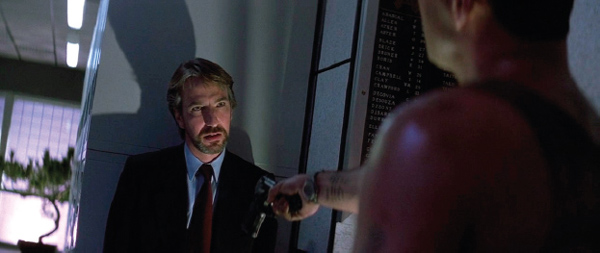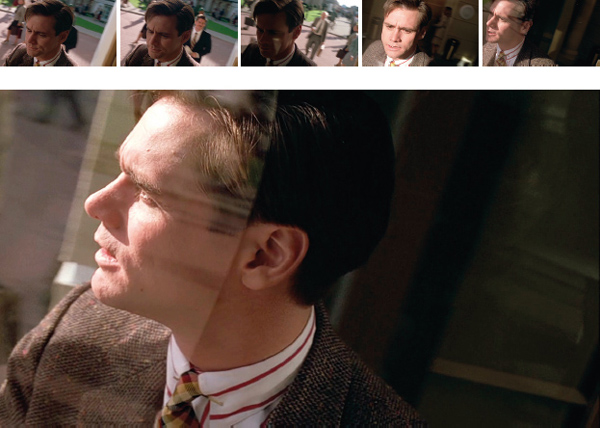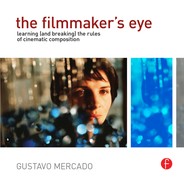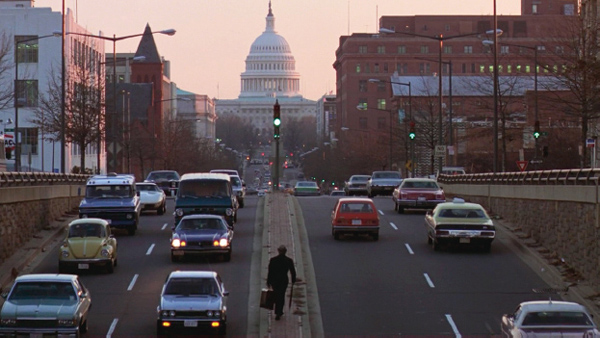canted shot
Canted shots are composed with a camera tilted laterally, so that the horizon is not level and vertical lines run diagonally across the frame. The resulting compositions can create spatial imbalance or disorientation which can convey a sense of dramatic tension, psychological instability, confusion, madness, or drug-induced psychosis. Canted shots were originally introduced to the grammar of film in the 1930s, in German expressionistic films that used them to externalize the inner turmoil or deranged state of a character’s psyche. The shot was also known as a “Deutsch angle” (“Deutsch” is the word for “German” in German) shot, which over time was confused and changed into today’s “dutch angle” shot, even though its historic roots have no connection with the cinema of the Netherlands. Although canted shots are commonly used to represent a character’s altered or abnormal state of mind, they can also be used to represent the collective psychology of a group, usually when they are experiencing a stressful or unusual situation. Another common use of the canted shot is to convey that an unnatural or abnormal situation is taking place, without necessarily reflecting a character’s psychology. The degree to which the frame is canted is normally interpreted as reflecting the level of abnormality, disorientation, or uneasiness being conveyed. Extremely canted shots, with the camera tilted close to 45 degrees, are very jarring to audiences and are therefore reserved for extreme situations; conversely, tilting the camera only a few degrees can introduce a sense of underlying instability to a scene without being too distracting. Because canted shots can be very overt and noticeable to audiences, it is common to restrict their use to only a few or even just a single shot within a scene. However, if the canted angle is not too great, sometimes entire scenes are shot using them. Like all other compositional manipulations, the effect of the canted shot is lost if used too often. Two rare examples of an extensive use of canted shots include Carol Reed’s The Third Man (1949), and Hal Hartley’s Fay Grim (2006).
An example of a canted shot used to convey a collective altered state of mind can be seen in Mel Gibson’s Apocalypto (2006). Set during the decline of the Mayan civilization, it follows the story of a Mesoamerican tribesman, Jaguar Paw (Rudy Youngblood), after he is abducted and taken to a large Mayan city. As he is being prepared for ritual sacrifice, a Solar eclipse takes place; the Mayan population, believing the eclipse to be an evil omen, break into a panic and beg a high priest (who obviously understands the true nature of the celestial phenomenon) to bring the sun back. At this point Gibson uses a canted shot of a group of Mayan citizens to convey their collective hysteria, visualizing their belief that the natural order of the world has suddenly gone out of balance, a mindset reflected by the high degree of inclination used in the composition of this shot.
A canted shot is used to convey the collective hysteria of the Mayan population as they experience a Solar eclipse in Mel Gibson’s Apocalypto (2006).
canted shot

why it works
In addition to conveying a character’s altered state of mind, canted shots can also amplify the tension of a dramatic moment, especially when something unsettling or abnormal is taking place in a scene, as seen in this example from John McTiernan’s Die Hard (1988). After a group of mercenaries takes over a high rise building, New York cop John McClane (Bruce Willis) manages to systematically thwart their plans to steal millions from a vault. In this key scene, McClane stumbles upon Hans Gruber (Alan Rickman), the mastermind behind the mercenaries, who pretends to be one of the hostages to gain his trust. The entire scene is shot using slightly canted angles, adding tension to their exchange and signaling that something unsettling is taking place. As the scene continues, it is revealed that McClane suspected Gruber’s true identity all along, and only pretended to trust him to pump him for information.
technical considerations
lenses
The effect of a canted shot can be augmented or minimized depending on the focal length used. Since canted shots are made apparent by the inclination of vertical lines present in the frame, it is important to create compositions that include them prominently; this is especially important if the canted angle is very slight and the framing is tight enough to exclude most of the surrounding area. This is where your choice of focal length can make a difference. Depending on the details of your scene, using a wide angle lens that extends distances along the z axis can make verticals in the background of your frame less apparent than if you were using a telephoto lens that would bring them closer to the foreground (since a telephoto compresses distances along the z axis). However, manipulating the focal length alone is not enough if other aspects of your composition, including depth of field, lighting, and art direction, are not also taken into account. For instance, in the example from Gibson’s Apocalypto at the beginning of this chapter, a telephoto lens was used to compress space along the z axis of the frame, not to make the canted shot more apparent (since it already uses a very inclined angle), but to compress the Mayan citizens into a unified mass, visually conveying their shared collective mindset as they witness a Solar eclipse. On the other hand, the wide angle lens used in the example from McTiernan’s Die Hard, on the previous page, added optical distortion to the composition; combined with lighting and blocking choices, the added distortion emphasizes the unsettling tone suggested by the use of the only slightly canted shot.
equipment
Most tripods will let you loosen their head mounts, allowing you to tilt the camera to create a slightly canted shot without the need to adjust the legs. If a more canted angle is desired, you can extend one of the tripod legs longer than the other two, or even attach the base plate that holds the camera to the tripod sideways, so that its tilting action will slant the camera laterally. Regardless of the method you choose to create a canted shot, keep in mind that any adjustment that renders the camera unbalanced requires extra measures to prevent the tripod from tipping over.
lighting
Any manipulation of the depth of field will involve controlling the amount of light reaching the film or CCD sensor. In the example from Apocalypto, a telephoto lens was combined with a relatively small aperture to ensure that as many individuals as possible included in the canted shot were in focus, even though the eclipse effect (a combination of a live effect with digital tweaking during postproduction) reduced the amount of available light; this was accomplished thanks to the high sensitivity of the Panavision Genesis (a high end HD camera) used to shoot this movie. A smaller aperture could also have been used in the example from Die Hard, without sacrificing the low-key lighting used to add an ominous mood to the scene, simply by increasing the output of the lights used on the set. While a smaller aperture would have produced a sharp background that would have made the verticals in that area of the frame more apparent, it would have also potentially taken attention away from the main subject of the composition, breaking one of the rules for over the shoulder shots.
breaking the rules

Since canted shots already suggest an altered or uneasy situation, it is unusual to see them combined with disorienting camera moves. However, a key moment in Peter Weir’s The Truman Show (2002) is underlined by the use of a canted shot that is imaginatively complemented with a dynamic camera attached to a revolving door, conveying Truman Burbank’s (Jim Carrey) unsettling realization that things are not what they seem in his idyllic hometown.
Being There. Hal Ashby, 1979.


